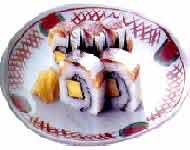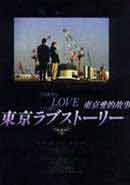| 日本:至酷国度(图) | |
| http://www.sina.com.cn 2004/09/02 10:36 《英语学习》 | |
Japan: the Coolest of the Cool 至酷国度 -想容 编注 浪漫凄美的爱情电影,人见人怜的卡通小猫,纤巧精致的什锦寿司……我们被日本流行文化团团包围啦! Since Japan hit the economic wall just over a decade ago, there has been an unseemly rush to write it off.1 For many, uneasy with the country's remarkable rise from the ashes of World War II, the worry came easily.
But they have missed a couple of salient2 points. First, in economic terms, Japan's economy remains the world's second-largest, still dwarfing3 many other developed countries. What's more, the economy is looking stronger than it has in years. But forget the economy ?the real Japan story today is not gross national product, but gross national cool.4 In a development which some say could rival the emergence of Japan Inc. in the 1980s, Japanese culture ?displayed in what the world watches and listens to, eats and wears ?is sweeping the globe.5 Japan, no longer hot, is very cool. "Japan's pop culture, gradually cultivated since the end of the war, is being recognized by the global community," said Ichiya Nakamura, executive director of research at the Stanford Japan Research Center. "In other words," said Mr Nakamura, who has charted6 the trend, "people overseas have come to acknowledge that Japan is an originally cool country." Last year, this concept was expounded7 by Douglas McGray in the article "Japan's Gross National Cool" published in Foreign Policy. "Japan is reinventing superpower again," he said. "Instead of collapsing beneath its political and economic misfortunes, Japan's global cultural influence has grown.8 "In fact, from pop music to consumer electronics, architecture to fashion, and food to art, Japan has far greater influence now than it did in the 1980s, when it was an economic superpower." Look no further than your local cinema for evidence. Tom Cruise's The Last Samurai, the story of an American Civil War hero who embraces the samurai and their way of bushido, is a clue.9 "The samurai swords, the costumes, the amazing landscapes," Cruise said in a recent interview. "There's just something about it all that's eternally cool." The Japan connection continues with Lost in Translation, Quentin Tarantino's Kill Bill, and the Australian Japanese Story, about an Australian geologist and a Japanese businessman finding each other in the outback.10 Then there is the pervasive influence of Japanese animation, which some estimates suggest has 60 per cent of the world market.11
"You can ask children in the US, Europe and many other places, 'What is the image of Japan?' Their answer would be Pikachu, DragonBall Z, Sailor Moon and Super Mario Brothers,12" writes Mr Nakamura in his recent paper on Japan's pop culture. Last year, Hayao Miyazaki's Spirited Away won the Golden Bear at the Berlin Film Festival, a first for animation films.13 Running in tandem with the animation industry has been the entertainment technology of Japan, seen in Sony and Nintendo game consoles, and the development of video games.14 Even old-technology manga ?Japanese comic art that transcends age barriers and inspired the Astro Boy-Pokemon genre ?is making inroads abroad.15 Raijin Comics Weekly is finding a big market in the US and Europe with an English manga, complete with authentic Japanese-style pages turning right to left.16 Beyond Pokemon, the enduring Japanese icon of Hello Kitty, created by Japanese company Sanrio in 1974,17 continues to make new friends across the world, extending her reach to the US and Europe. "Kitty's success is part of the rise of what we call the 'culture of cute', a unique blend of post-modern desire and infantile affectation,18" states Mr Nakamura. "This grew up first in Japan in the 1970s and 1980s and is now spreading overseas." While Japanese pop culture is now making significant inroads into the West, it is already huge in Asia. In June the Asian edition of Time magazine ran a cover story "Japan Rules OK!", a "special report on Asia's pop culture superpower". The magazine listed the pervasive areas of cool: music, art, fashion and design, and their potential to generate a new kind of prosperity for the country. Just where this has all stemmed from19 makes an interesting study of the evolution of a modern society. The dominant, and often accurate, view of postwar Japan was that it was a tightly controlled and uptight society: the loyal salarymen toiling through stress-filled lives; obedient youngsters heading off to cram-schools.20
So what happened? One theory is that, in part, the 1990s ?the lost decade in Japan's economy ?helped drive this revolution. The downturn meant that younger people began questioning the values of Japan's economic machine. A new breed of youth emerged, shunning the corporate world for life as part-time workers.21 Walk around the streets of Shibuya, Japan's youth mecca near the heart of Tokyo,22 and you realize just how seriously cool Japan has become. The fashions are edgy and eclectic, worn by self-assured youngsters at ease with their distinctive place in the world.23 There are plenty of US influences, but they are modified and supplanted by the home-grown. Not surprisingly, the business potential of the cool industry has not been missed. Recently, the Nikkei newspaper, Japan's top financial journal, ran a Cool Japan symposium24. Such a conference run by a financial newspaper made sense, for there is big money for Japan in the pop culture business. As Mr Nakamura points out, the entertainment industry is worth between 43,000 billion and 53,500 billion yen ($A540 billion to $A674 billion) a year, about 10 per cent of the country's GNP.
In the context of an economy only second in size to America's, Japanese cool is big business. Just how far Japan's Gross National Cool can go is uncertain. While Pokemon, sushi and Japanese themed movies transplant well, it is difficult to see how something like Japanese pop music can follow suit.25 Yet who would have thought a too-cute cat without a mouth would have been so enthusiastically embraced as a global figure? But there are dangers ahead in the line between fad and long-term trend. Mr Nakamura believes it can be the latter. He wants to maximize digital technology, develop professionals for the pop culture industry, and introduce pop culture education in schools. And he is thinking long term: "Japan should have a strategy for its pop culture to be popular around the world for five decades ?or even 10." 1. 日本自10多年前经济触礁以来就一直不顾时机地急于摆脱困境。unseemly:不适宜的,不得体的;write off:结束掉,毁掉。 2. salient:显著的,突出的。 3. dwarf:超过,使相形见绌。 4. 不过还是别谈经济了——今天日本真正的厉害之处不是国民生产总值(GNP),而是国民“酷”总值。 5.日本文化正席卷全球——体现在世人看的、听的、吃的和穿的等各个方面,一些人认为其发展可与20世纪80年代“日本公司”蓬勃兴起的状况相提并论。rival:与……匹敌,比得上;Japan INC.: 20世纪80年代,美国的汽车及电子产品制造业受到日本的强力挑战。"日本公司"一词应运而生,意指日本经济兴盛的原因在于其整体合作精神。日本人石森章太郎于1988年出版的一本介绍日本经济的著作即题为《日本公司》。 6. chart:用图表表示(或说明)。 7. expound:解释,详细说明。 8.“日本正在重新确立其超级大国的地位,”他说,“日本在全球范围的文化影响力并没有在其政治和经济厄运的压力下崩溃,相反,这种影响还增强了。” reinvent:重新确立,重新使用。 9. The Last Samurai: 《最后的武士》,由好莱坞著名演员汤姆·克鲁斯主演;embrace:(乐于)采取,(欣然)接纳; bushido:武士道。 10. Lost in Translation: 《迷失东京》,讲述了两个美国人在日本东京发生的一段故事;Kill Bill:《杀死比尔》,由素有“鬼才”之称的导演昆汀·塔伦蒂诺执导的影片,其中请日本剑道学家千叶真一设计并指导了精彩的打斗场面; Japanese Story: 《日本故事》,该片的男主人公是日本籍商人; outback: (尤指澳大利亚的)内地。 11. pervasive:遍布的,流行的; animation:卡通片,动画片。 12. Pikachu: 皮卡丘,是任天堂公司推出的游戏《宠物小精灵》(Pokemon)中的形象;DragonBall Z: “七龙珠”,日本著名漫画,已被制作成游戏,此处指其中的卡通形象;Sailor Moon: 月野兔,日本漫画《美少女战士》中的主要人物;Super Mario Brothers: “超级马利奥兄弟”,日本任天堂公司出品的游戏,此处指其中的卡通人物。 13. Hayao Miyazaki:宫崎骏,日本最出名的动画大师,代表作有《千与千寻》、《幽灵公主》、《风之谷》、《红猪》等;Spirited Away:《千与千寻》,获第75届奥斯卡最佳动画片奖和第52届柏林国际电影节金熊奖。 14. 与卡通片行业齐头并进的是日本的娱乐技术,表现在索尼与任天堂公司的游戏机以及电视游戏业的发展。 in tandem with:同……呈纵列。 15.连老式的“漫画”艺术也开始向国际市场进军,这种日本漫画艺术超越了时代的界限,刺激了《铁臂阿童木》和《宠物小精灵》一类作品的产生。manga:“漫画”,该词于1814年提出,用来描述三卷绘画作品,风格多以随意、夸张为主,作品的内容来自神话、历史和日常生活,manga并不是西方的“卡通(comic)”或“卡通书(comic books)”,也不是 “连环画(sequential art)”或“画书(graphic novel)”;Astro Boy: 《铁臂阿童木》,日本经典漫画;Pokemon: 即漫画《宠物小精灵》,下文中出现的“Pokemon”则指其中的形象,故未用斜体;genre:(艺术等)类型,流派; inroads:(常用复数)侵袭。 16. Raijin Comics Weekly(日本知名漫画杂志)在美国和欧洲销路可观,它除了刊登英式风格的漫画外,还附有从右向左翻页的那种真正的日式漫画。complete with:包括,连同。 17. Hello Kitty:凯蒂猫,最初是绘在贺卡上的卡通形象,如今由其生产公司推广至儿童产品、时尚行业乃至经授权的多种商品,风靡全球;Sanrio:三丽欧公司,成立于1960年8月,公司的业务范围包括:社交礼品和贺卡的设计与销售,主题公园的规划与管理以及录像节目的制作和销售等,Hello Kitty是其成立以来推出的最成功的卡通形象。 18. infantile:幼稚的,孩子气的; affectation:矫揉造作,装模作样。 19. stem from:起源于……,由……造成。 20. 对战后日本主要的、通常也是正确的看法认为,它是个高度克制而极端保守的社会:尽职尽责的工薪阶层在压力重重的生活里辛苦操劳;中规中矩的年轻人急急赶赴各类补习班。uptight: 极端保守的,过分拘谨的; toil(through):辛勤劳动,辛苦从事;cram-school:补习班,辅导班。 21. 新一类年轻人由此而生,他们为了躲避办公室生活而选择去做兼职。 22. Shibuya:涩谷,是与银座、新宿齐名的繁华商业街,同时又是年轻人文化的发源地; mecca:众人渴望去的地方。 23. 这里的服装前卫而多样,穿着这些服装的年轻人自信满满,对自己在世界上的特殊地位感觉惬意。eclectic: 五花八门的;self-assured: 自信的;at ease:安适,不拘束,自在。 24. symposium:讨论会,座谈会。 25. 尽管《宠物小精灵》、寿司和日本主题电影在海外都“移植”得不错,但很难预见像日本流行音乐之类的东西如何才能“步其后尘”。transplant: 移植,移居,这里指拓展至海外市场;follow suit:跟着做,照样。
| |
【评论】 |
| 【英语学习论坛】【大 中 小】【打印】【关闭】 |



